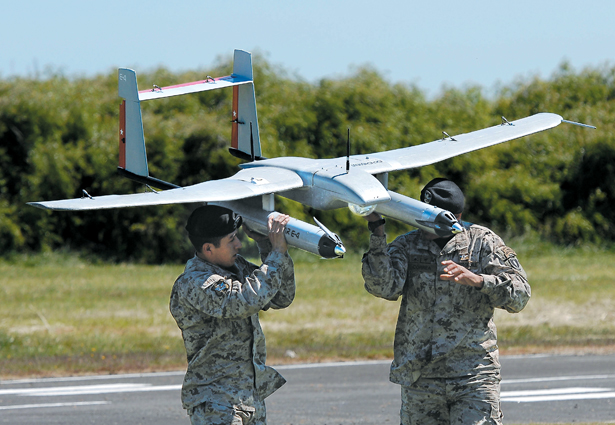Interstate conflict is rare in Latin America. Yet some nations in the region are emerging as world leaders in advanced military technology. From drones to complex border surveillance systems, their research and development (R&D) laboratories have come up with sophisticated tools to counter this century’s unconventional threats to national security.
That’s reflected in part by a 15 percent increase in military spending in the region between 2010 and 2013—a sharp contrast with the global decrease in military budgets. Total defense spending for Latin America and the Caribbean increased to $74 billion in 2013. Latin American militaries allocate an average 68 percent of their total annual budgets to personnel, and there have been additional purchases of big-ticket items like combat aircraft (most recently, by Brazil and Chile). But the figures also show an increased focus on science and technology (S&T) development—and with it the strengthening of domestic defense industry establishments that has begun to drive exports.
The region’s biggest perceived threats can be gleaned from the headlines: transnational crime, narcotics trafficking and domestic insurgencies. These same threat perceptions are reflected in the area’s defense strategies. For example, the military budgets in Guatemala, Honduras and Nicaragua, where gangs and drug cartels have accounted for a rise in violence, grew an average of 17 percent between 2012 and 2013. Just a few years ago Mexico’s Navy, the Secretaría de Marina (SEMAR), switched from the planned purchase of 12 fighter jets to 15 turbo-prop maritime surveillance aircraft, a reflection of the increased attention paid to illicit drug traffickers who are operating in coastal areas.
This also tracks with Washington’s own threat perceptions in the region. According to Ricardo Arias, program manager at the United States Southern Command’s Science, Technology and Experimentation Division, U.S. S&T efforts in the region have similarly been oriented toward improving Latin America’s capacity to counter illicit trafficking and criminal networks and monitor land, air and maritime spaces threatened by non-state actors. U.S. agencies have invested millions of dollars in research efforts that support the region’s capacity to combat these asymmetrical threats. The U.S. Departments of Defense, State, Homeland Security, Transportation, and Treasury have all supported S&T in the region.
Not all Latin American militaries have abandoned the pursuit of conventional military hardware, however. Argentina, Brazil, Chile, Uruguay, and Venezuela continue to develop and procure technologies seemingly designed for more conventional interstate conflicts, such as fighter jets, attack helicopters, submarines, and artillery rocket systems. Nonetheless, even these nations are increasingly concentrating resources on developing dual-use technologies, such as offshore patrol vessels (OPVs), unmanned aerial vehicles (UAVs)–commonly called drones–and military transports that enable militaries to combat both conventional and nonconventional threats.
Countries’ capacity for R&D varies greatly across the region. Most militaries in Latin America depend on foreign procurement, with supply sources ranging from the U.S. and Israel to Europe and Russia. Much of the military technology in place in Central America and the Caribbean to combat transnational organized crime is imported. However, an emerging group of Latin American militaries are working with academic institutions, the private sector and government organizations to develop a domestic R&D base and indigenous defense industries that focus on cutting-edge technology.
Brazil, Chile and Colombia, which together accounted for nearly 75 percent of Latin America’s total 2013 military spending, are paving the way in military S&T. They are the only countries in the region that have well-funded R&D operations with strong intellectual capital to support innovation. Close behind in S&T development are Argentina, Ecuador, Mexico, Peru, and Uruguay.
Brazil is the regional leader in military science and technology. The country’s total R&D budget exceeds 1.25 percent of GDP, making it the biggest regional spender. The Brazilian military has developed its own software-defined radios, cybersecurity technologies, UAVs, satellites, submarines, aircraft, as well as modern infantry weapons. The Brazilian defense and aerospace industry is the most robust in Latin America, consisting of more than 90 companies. At the top of the list is Embraer, whose technologies, including attack aircraft, military transport aircraft and surveillance aircraft, are exported all over Latin America, as well as to other global markets.
Colombia is another success story in military S&T. The military has designed and developed a wide range of technologies, from personal ballistic protection equipment, military robots and radar, to OPVs. Colombia is quickly becoming known for its advanced riverine boats made for inland waterways. The principal players are for-profit companies that are wholly owned by the Colombian Ministry of Defense. Two examples are the Corporación de Alta Tecnología (High-Tech Corporation—CODALTEC) and the Corporación de Ciencia y Tecnología para el Desarrollo de la Industria Naval, Marítima y Fluvial (Science and Technology Corporation for the Development of Naval, Maritime and Riverine Industry—COTECMAR).
CODALTEC is developing land radar technologies to combat domestic insurgencies and illicit traffickers, and COTECMAR is known for designing and producing OPVs. These companies are increasing Colombia’s capacity to export military technology–its military OPVs and ballistic protection products are now exported worldwide.
Latin American military technologies being developed to combat illicit non-state actors largely center on intelligence, surveillance and reconnaissance; as well as transport and interdiction on land, air and sea. The region is experiencing a marked increase in the development and procurement of UAVs. Most militaries in South and Central America use UAVs, and many of the militaries are pursuing their own UAV systems: Argentina has created the Lipán M3; Brazil, the VT-15s; Colombia, the Navigator X2 and Iris; Ecuador, the Fénix; and Mexico, the S4. Many of these UAVs have image and facial recognition capabilities.
The increasing prevalence of drones in Latin America raises questions about citizen privacy, as regulatory policy lags behind technological advances. OPVs and coastal surveillance radars that provide intelligence and surveillance capabilities are also on the rise. Other technologies being used to combat new asymmetrical threats include wireless remote sensing networks that track and monitor movement in rural areas, ground- and air-based radars, surveillance aircraft, personnel transports, lethal and nonlethal weapons, and cyber technologies.
Here are some other examples of indigenous Latin American military S&T.
Brazil’s Integrated Border Monitoring System
Brazil’s Sistema Integrado de Monitoramento de Fronteiras (Integrated Border Monitoring System—SISFRON) is the most sophisticated large-scale, operational border-monitoring system in the world. The system is essentially an electronic fence along Brazil’s nearly 10,500 miles of borders with Argentina, Bolivia, Colombia, French Guiana, Guyana, Paraguay, Peru, Suriname, Uruguay, and Venezuela.
SISFRON, which debuted in November 2014 and is still being built, uses a mix of surveillance radars, remote sensing networks, complex communications systems, cybertechnologies and UAVs to provide Brazilian security forces with surveillance and electronic warfare capabilities to prevent illicit goods from entering the country. SISFRON will also strengthen interoperability between military and police forces and enhance overall interagency coordination along Brazil’s borders. SISFRON is being managed and developed by the Embraer-run Tempro Consortium, comprised of mostly Brazilian and some foreign technology companies. SISFRON, once it is fully operational, is expected to cost approximately $5 billion to build.
Brazilian Aerospace Technologies
Embraer is one of the largest aircraft manufacturers in the world, currently supplying over half the Brazilian Air Force fleet. Its top technologies include the EMB-314 (A-29), the EMB-145 and the KC-390, all of which provide surveillance and/or transport capabilities to the Brazilian military, as well as to other militaries in the region. The A-29, also known as the Super Tucano, is used by the Chilean, Colombian, Dominican, Ecuadorian, and Honduran militaries, as well as by the U.S. armed forces. The EMB-145 is Brazil’s premier surveillance aircraft. Variants of the EMB-145 include models for airborne early warning, remote sensing and maritime patrol. The Mexican Air Force uses the maritime patrol model. The KC-390 is a recent addition to Brazil’s fleet. Though still in development, it is already sought after by Argentine, Chilean and Colombian Air Forces. The KC-390 is a twin-engine jet-powered military transport aircraft meant to rival the U.S.-made C-130.
Chile’s Láscar DRONE
Láscar is the first domestically produced UAV in Chile. The Chilean Army, in collaboration with the Universidad de Concepción, developed the twin-engine, long-range drone to support the military’s capacity to provide critical real-time data and video in the aftermath of natural and manmade disasters. Láscar can also be used to monitor portions of Chile’s 2,700-mile (4,345 km) coastline and its northern borders with Bolivia and Peru in order to disrupt illicit trafficking. Developed in 2008, Láscar successfully completed its first test flight in 2012. But the program experienced a setback in 2013 after operators lost communication with the UAV and it crashed into a rooftop in Hualpén, Chile. No one was injured. Láscar can be launched from a moving vehicle or by catapult and can stay aloft for two hours at a range of nearly 30 miles (48 km) from its controller. It can reach an altitude of 11,000 feet (3,353 m) and resist winds in excess of 35 miles (56 km) per hour.
Colombian Offshore Patrol Vessels
Several navies across the region have focused on offshore patrolling capability. Most, like Argentina, Chile and Ecuador, plan to import OPVs or use domestic ship-building capacity to build imported designs. Colombia, however, has leveraged its S&T capabilities to design and develop its own version, using imported technologies. On October 31, 2014, Colombia’s first indigenous OPV hit the waters to support the fight against illicit traffickers and the Fuerzas Armadas Revolucionarias de Colombia (Revolutionary Armed Forces of Colombia—FARC). COTECMAR’s ARC class of OPVs combines surveillance technologies with offshore patrolling capability, serving for surveillance purposes and as a weapons-launching platform.







